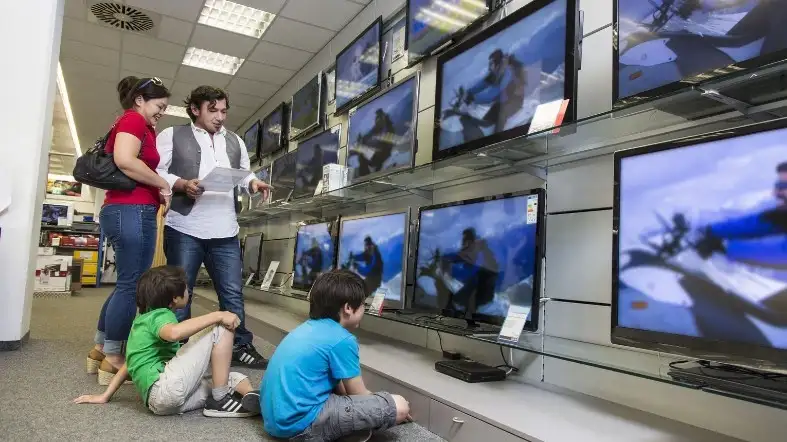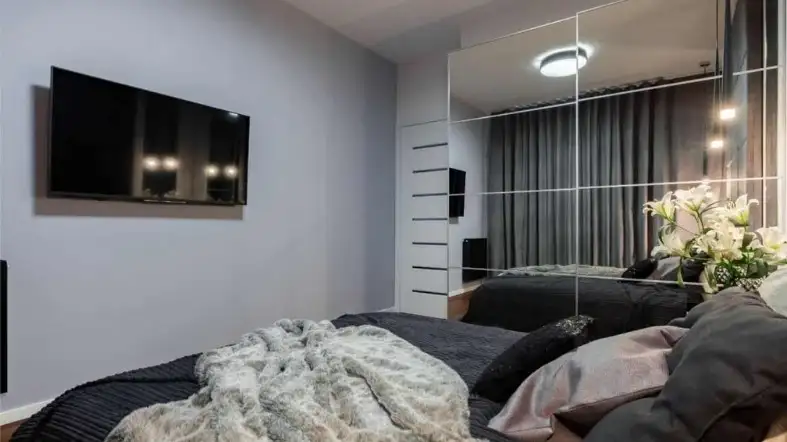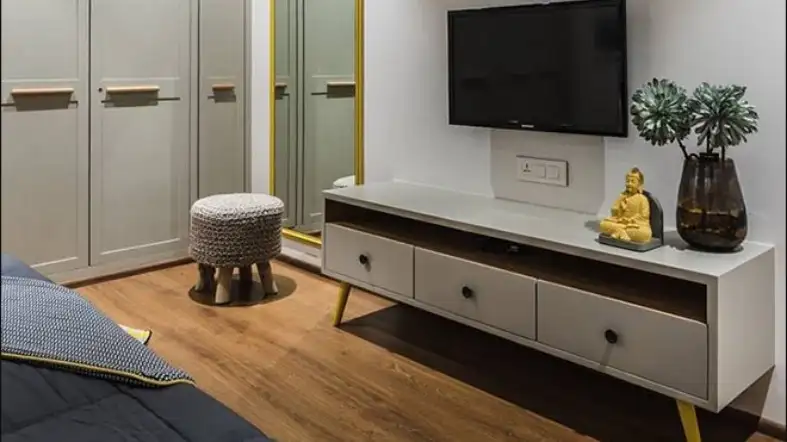Are you on the hunt for the perfect TV to elevate your bedroom entertainment experience?
Whether you’re binge-watching your favorite series, enjoying movie nights, or even gaming, the right TV size can make all the difference.
But how do you navigate the sea of options to find the perfect fit? Welcome to our comprehensive guide on “What Size TV For A Bedroom?”
In this article, we’ll unravel the complexities and break down the factors that matter most. From resolution to viewing distance, room layout, sound quality, smart features, and personal preferences, we’ve got you covered.

TV Size Chart For A Bedroom
For smaller bedrooms, the ideal TV size is a 32 to 43-inch TV whereas a 50 to 55-inch TV fits well in larger spaces. The right TV size for a bedroom is determined by the viewing distance from the bed to the TV. Always consider the room layout and personal preference.
Bedroom TV Size Chart:
| TV Size | Resolution | Viewing Distance | Room Dimension |
|---|---|---|---|
| 32″ | 1080p | 4 – 6 feet | 10 x 10 feet |
| 40″ | 1080p | 5 – 8 feet | 10 x 11 feet |
| 43″ | 4K | 4 – 7 feet | 10 x 12 feet |
| 50″ | 4K | 5 – 8 feet | 11 x 13 feet |
| 55″ | 4K | 7 – 11 feet | 12 x 14 feet |
| 60″ | 4K | 8 – 12 feet | 13 x 15 feet |
| 65″ | 4K | 9 – 13 feet | 14 x 16 feet |
| 70″ | 4K | 10 – 15 feet | 15 x 17 feet |
| 75″ | 4K/8K | 11 – 16 feet | 16 x 18 feet |
| 80″ | 4K/8K | 12 – 17 feet | 17 x 19 feet |
| 85″ | 4K/8K | 13 – 18 feet | 18 x 20 feet |
Resolution
Resolution is the number of pixels that make up the image on the TV screen. The more pixels, the sharper and clearer the image.
The most common resolutions for TVs are 1080p (Full HD), 4K (Ultra HD), and 8K.
- 1080p TVs have a resolution of 1920 x 1080 pixels, which means they have about 2 million pixels in total.
- 4K TVs have a resolution of 3840 x 2160 pixels, which means they have about 8 million pixels in total.
- 8K TVs have a resolution of 7680 x 4320 pixels, which means they have about 33 million pixels in total.
The higher the resolution, the more details you can see on the screen, especially when watching high-resolution content such as Blu-ray discs, streaming services, or game consoles.

However, resolution is not the only factor that determines the picture quality.
Other factors such as contrast ratio, color accuracy, brightness, and HDR performance also play a role in how good the image looks.
Another thing to consider is that the higher the resolution, the closer you can sit to the TV without noticing individual pixels or losing image quality.
This means that if you have a small bedroom or you like to sit close to the TV, you might benefit from a higher-resolution TV.
On the other hand, if you have a large bedroom or you prefer to sit far from the TV, you might not notice much difference between a lower-resolution and a higher-resolution TV.
Viewing Distance
Viewing distance is the distance between your eyes and the TV screen.
The optimal viewing distance depends on the size and resolution of the TV, as well as your eyesight and personal preference.
Generally speaking, the optimal viewing distance is about 1.5 to 2.5 times the diagonal size of the TV screen.
This means that for a 40-inch TV, the optimal viewing distance would be around 5 to 8 feet. For a 55-inch TV, it would be around 7 to 11 feet. For a 75-inch TV, it would be around 10 to 15 feet.
The optimal viewing distance is based on scientific principles of vision and resolution that determine how well you can see the details on the screen without losing image quality or experiencing eye strain.

However, these are only guidelines and not rules. You can adjust your viewing distance according to your personal preference and comfort level.
Some people may prefer a larger screen for a more immersive experience, while others may prefer a smaller screen for a more intimate experience.
To help you find your ideal viewing distance based on your TV size and resolution, you can use this TV Viewing Distance Calculator.
Room Layout
Room layout is another factor to consider when choosing a TV size for your bedroom.
You need to measure your room dimensions and determine where you want to place your TV and where you want to sit when watching it.
You also need to consider other furniture and objects in your room that might affect your viewing angle or cause reflections or glare on the screen.
Ideally, you want to place your TV at eye level or slightly below when sitting on your bed or couch.
This will ensure a comfortable and natural viewing angle that won’t cause neck strain or fatigue.
You also want to avoid placing your TV near windows or other light sources that might create reflections or glare on the screen that can reduce contrast and visibility.
You can use curtains or blinds to block out unwanted light or adjust your TV settings to increase brightness and contrast.
You also want to make sure that your TV fits well in your room without being too big or too small for your space.
A TV that is too big might overpower or look out of place in your room, while a TV that is too small might not provide enough screen area or impact for your viewing pleasure.
You can use this TV Size Calculator to find out what size TV fits best in your room based on your room dimensions.
Sound Quality
Sound quality is another factor to consider when choosing a TV size for your bedroom.
The sound quality of the TV can affect your enjoyment and immersion of the content you watch, as well as your comfort and relaxation.
You want to choose a TV size that has good built-in speakers or can be paired with external speakers or soundbars that can deliver clear, balanced, and rich sound.
Built-in speakers
Most TVs have built-in speakers that are located at the bottom, back, or sides of the TV.
The sound quality of these speakers can vary depending on the TV model and brand, but generally speaking, they are not very powerful or impressive.
They may sound tinny, muffled, or distorted, especially at high volumes or low frequencies.
They may also not be able to produce surround sound effects or create a wide soundstage that can fill your room.
If you rely on the built-in speakers of your TV, you may want to choose a larger TV size that can have bigger and better speakers than a smaller TV size.
External speakers
If you want to improve the sound quality of your TV, you may want to invest in external speakers or soundbars that can connect to your TV via HDMI, optical, or Bluetooth.
External speakers can offer more power, clarity, bass, and detail than the built-in speakers of your TV.
They can also create a more immersive and realistic sound experience by producing surround sound effects or Dolby Atmos effects that can make you feel like you are in the middle of the action.
External speakers come in different sizes and shapes, so you can choose the ones that fit your room and budget.
However, you also need to consider the space and wiring required for external speakers, as well as the compatibility and synchronization issues with your TV.
Smart Features
Smart features are another factor to consider when choosing a TV size for your bedroom.
Smart features are the functions and capabilities of the TV that allow you to access online content and services, such as streaming platforms, apps, games, web browsers, voice assistants, and more.
You want to choose a TV size that has smart features that suit your needs and preferences and enhance your convenience and entertainment.
Streaming platforms
Streaming platforms are online services that allow you to watch movies, shows, documentaries, sports, and more on demand.
Some of the most popular streaming platforms are Netflix, Amazon Prime Video, Disney+, Hulu, HBO Max, YouTube, and more.
If you are a fan of streaming content, you may want to choose a TV size that has built-in streaming apps or can support external streaming devices such as Roku, Fire TV Stick, Chromecast, Apple TV, and more.
You may also want to choose a TV size that has a high resolution and HDR support that can display the best quality of the streaming content.
Apps and games
Apps and games are other online content and services that you can access on your TV.
You can download various apps on your TV that can offer different functions and features, such as music, news, weather, social media, fitness, education, and more.
You can also play various games on your TV that can offer different genres and levels of difficulty, such as action, adventure, puzzle, strategy, sports, and more.
If you are interested in apps and games on your TV, you may want to choose a TV size that has a smart operating system or platform that can support a wide range of apps and games.
You may also want to choose a TV size that has a fast processor and a high refresh rate that can run the apps and games smoothly and without lag.
Web browsers and voice assistants
Web browsers and voice assistants are other smart features that you can use on your TV.
Web browsers allow you to surf the internet on your TV screen and access various websites and online content.
Voice assistants allow you to control your TV with your voice commands and ask questions or perform tasks on your TV.
If you want to use web browsers and voice assistants on your TV, you may want to choose a TV size that has a built-in web browser or can support external web browsers such as Google Chrome or Firefox.
You may also want to choose a TV size that has a built-in voice assistant or can support external voice assistants such as Alexa or Google Assistant.
Aesthetics
Aesthetics is another factor to consider when choosing a TV size for your bedroom.
Aesthetics is the appearance and style of the TV and how it matches with your room decor and ambiance.
You want to choose a TV size that has an attractive design and color that can complement your room theme and mood.
Design
The design of the TV refers to the shape and structure of the TV frame and stand.
The design of the TV can affect how it looks in your room and how much space it occupies.
- Some TVs have thin bezels or frames that make them look sleeker and more modern.
- Some TVs have curved screens that make them look more futuristic and immersive.
- Some TVs have Swivel or tilt stands. that make them more flexible and adjustable.
- Some TVs have wall-mounting options that make them more space-saving and elegant.
You can choose a TV size that has a design that suits your taste and style.
Color
The color of the TV refers to the hue and tone of the TV frame and stand.
The color of the TV can affect how it blends with your room color scheme and atmosphere.
- Some TVs have black or gray colors that make them look more neutral and classic.
- Some TVs have silver or white colors that make them look more bright and chic.
- Some TVs have colorful or metallic colors that make them look more vibrant and trendy.
You can choose a TV size that has a color that matches your room palette and vibe.
Personal Preference

Personal preference is perhaps the most important factor when choosing a TV size for your bedroom.
Ultimately, you want to choose a TV size that suits your taste and budget and makes you happy and satisfied with your viewing experience.
There is no right or wrong answer when it comes to personal preference, as different people may have different opinions and expectations about what makes a good TV size.
Some people may prefer a larger screen for a more immersive and cinematic experience, especially when watching movies or playing games.
Others may prefer a smaller screen for a more cozy and intimate experience, especially when watching TV shows or documentaries.
Some people may value picture quality over screen size, while others may value screen size over picture quality.
Some people may have a flexible budget that allows them to buy a bigger and better TV, while others may have a limited budget that restricts their options.
The best way to find out your personal preference is to try out different TV sizes and resolutions in person and see which one you like the most.
You can visit a local electronics store or showroom and compare different models and brands of TVs.
You can also read online reviews and ratings from other customers who have bought and used the TVs you are interested in.
You can also ask for recommendations from your friends or family who have similar tastes and preferences as you.
FAQs
Is there a standard TV size for bedrooms?
No, there is no standard TV size for bedrooms, as different rooms may have different dimensions, layouts, and viewing preferences. However, some general guidelines can help you choose the best TV size for your bedroom.
Are bigger TVs always better for bedrooms?
Not necessarily, bigger TVs may offer more screen area and impact, but they may also be too overwhelming or out of place in some bedrooms.
Can I use a projector instead of a TV for my bedroom?
Yes, you can use a projector instead of a TV for your bedroom, if you have enough space and darkness in your room.
is 65 inch TV too big for bedroom?
A 65-inch TV is a good size for rooms of 144 sq. ft (13×13) or above, such as master bedrooms, living rooms, and one-bed apartments
is 55 55-inch TV too big for a bedroom?
The 55-inch TV is suitable for a larger bedroom with a viewing distance of 8 to 10 feet.
Final Words
Choosing a TV size for your bedroom is not an easy task, as there are many factors to consider and many options to choose from.
However, by following the guidelines and recommendations in this article, you can make an informed and confident decision that will suit your needs and preferences.
